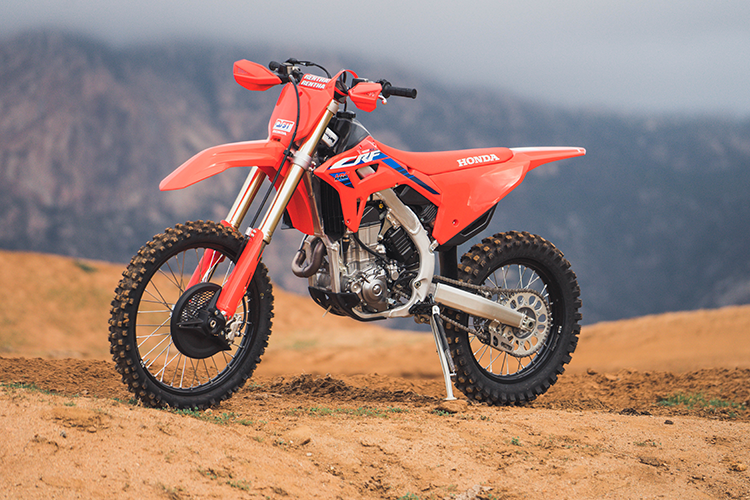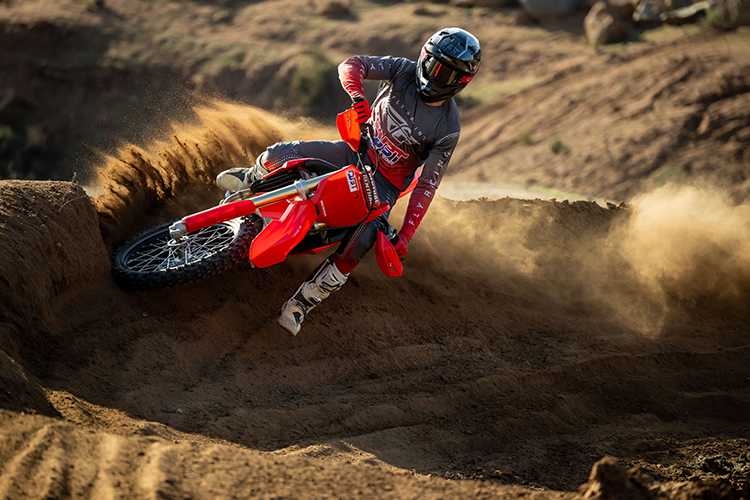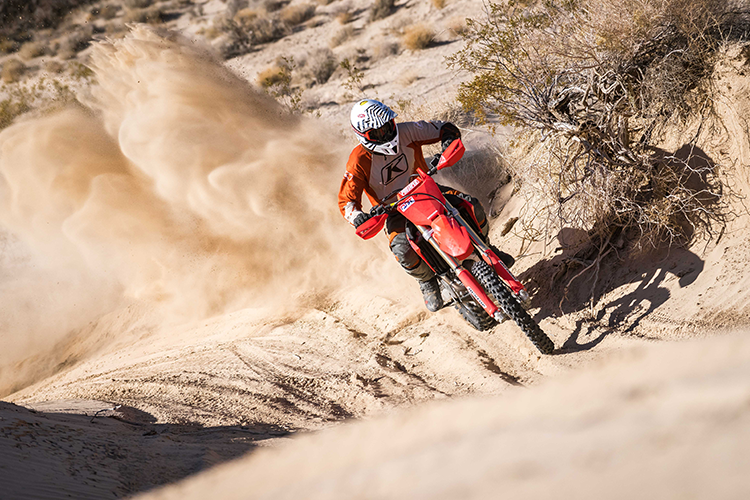CRF450RX vs CRF450X
Story by Trevor Hunter & Jimmy Lewis


Very few brands have the legacy and hardcore following that Honda has built over the last half century. Tracing back to the late 70’s and early-mid 80’s, Honda burst onto the American professional scene with many of the top talents, arguably the best production and works bikes at times, and amassed a plethora of race wins and championships in the early years of American motocross. As a result, they built a reputation and accumulated a dedicated following that still live by riding red to this day, all while passing that down to generations in the years after.
In recent years, Honda has increased its model lineup to include the RX models, designed to bridge the gap between the MX focused R models and trail/heavy off-road focused X models. Since both are considered off-road models, though with entirely different intended purposes and designs from the factory, we wanted to compare Honda’s CRF450RX and CRF450X and see how they stack up in the elements.
It’s important to note that these bikes were essentially tested stock. The only changes the CRF450RX has is a Dunlop MX33 front tire (stock is a Dunlop AT81), and Pro Taper CR Mid Contour Handlebars (stock is a Renthal 839 Fatbar). Aside from that, the 450RX is left stock with just clicker and sag adjustments made. The CRF450X is 100% stock with just clicker and sag adjustments made. Tires are very critical in the dirt and can drastically affect how a bike feels and performs, especially when a majority of time is spent on certain tires so keep this in consideration as we depict these bikes. We feel both these bikes could be that much better with tires we’re more familiar with and agree with than what comes stock and what was tested here.
POWER
Plain and simple, the 450RX motor is a beast. It has gobs of power at all times and is one of the fastest bikes in its class. Though the power delivery is more friendly and usable than in previous years, it’s still much more aggressive and robust than that of the X power delivery. The X is very smooth and linear in stock trim. It’s deceiving because you can barely hear the motor running, but it puts the power to the ground so effectively that it holds its own at times, especially when traction is at a premium. The RX does hit harder, pull harder, and rev much longer than the X – we tested this in third gear roll-ons and drag races – but it’s not as far off as one may think. It just goes to show how fast and capable these 450cc four-stroke motors are, even when “corked up.”
The RX has the different map modes on the handlebars, along with traction control, which the X doesn’t offer. The different map modes change the power enough and different riders are able to find what works best for them, almost like having different exhausts on hand to change the power delivery. We’re pretty varied on what mapping is liked best as we have different riders who all prefer the different map modes.
Both the X and RX engines have a light flywheel feel and are prone to stalling, especially considering a vague clutch feel on the X (more on that later), and strong or touchy brakes. We struggled with stalling the X bike a bit in tight terrain whereas the RX was able to keep chugging along a tad better and due to a more consistent clutch engagement.
Transmissions are a source of parity between these two bikes and can all but direct you to a certain bike depending on what you are looking for. The 450RX has a standard 5-speed, close ratio motocross style transmission – the same as the CRF450R. For some, this is adequate. However, as you venture into the far ends of the speed spectrum – both slow speeds and high speeds – the transmission lacks some range. First gear isn’t quite low enough for very tight and technical riding while fifth gear tops out too quickly. The 450X; however, struts its legs and then some with its transmission. The 6-speed transmission is a god-send for desert riders, dual sporters, and off-road riders alike. You get the luxury of having a LOW first gear while maintaining a tall gear for high speed roads and cruising comfortably at low RPMs. As a purebred race bike intended to race grand prix’s and GNCC style races, the transmission is good enough that you really aren’t sacrificing much, if any, at a majority of the races. Meaning there are not large gaps between gears. However, as a desert racer or someone who likes to do more than just one discipline with the same bike, the transmission can be a deal breaker.
Similar to the transmissions, the clutch systems are different between the two as well. The RX racer boasts a hydraulic clutch while the 450X features a more traditional, cable-actuated clutch. The RX clutch has a slightly tougher than average pull for a hydro clutch in comparison to a Brembo system (more like the Magura systems in pull effort with less throw– if you are familiar). The 450X clutch pull is a bit vague and inconsistent, something that can be fixed with an aftermarket basket and inner hub initially. Aftermarket clutch plates do help improve that feeling much more.
SUSPENSION
X suspension is soft, supple, and soaks up a lot. It’s definitely trail oriented and in its element out there, but as you get more aggressive and lift the speeds, the X shows some signs of weakness. It is holding up a heavy bike and suffers from pitching and using more stroke compared to a competition bike. It has excellent bottoming resistance and the components are of a high quality so modifications will work to get a rider any type of setting they desire. Overall, it performs well where it’s supposed to and that’s all we can ask for.
The RX suspension is stiffer, but still on the soft side for a competition bike in western conditions. We feel the RX could greatly benefit from some stiffer fork springs for our faster or heavier riders in our conditions. The front end dives on decel, rides lower in the stroke so it offers a harsher feeling (not to be confused with stiff), and we feel we have to band aid it with running a little lower sag or less high speed compression in the shock. In reality, the RX suspension is comparable to every other off-road race bike as we feel all the other OEMs struggle with this for most of our testers. We understand the other half of the country, not riding in faster or more open conditions needs a setting on the other side of the spectrum. It’s not unrideable by any means, but we know it can get much better with a little tuning regardless of where you are riding. It is a setting that splits the difference so it can not be horrible anywhere.
Something to note is that the RX and X use the same spec Showa components. Trail bikes don’t always get the best suspension systems equipped from the factory, so it is nice to see Honda offer this high quality suspension on the trail oriented CRF450X.
CHASSIS – HANDLING
The X is a bigger, heavier bike both on the scale and in the dirt. Does it feel its scale weight? Not entirely, but it has that bigger bike feel in comparison to the RX. The X isn’t quite as stable as we’d like it to be or think it should be considering all of this, dancing around the trail a touch. The X also feels wide, especially down low around the cases and lower frame. Some of this will be resolved with removing the plastic guards around the ignition and clutch covers, but it is wider than the RX in any form for those that are picky. This chassis is overall just smooth and comforting but we have learned a few tricks that make a noticeable difference and are free. Loosening and re-torquing the engine mounts and swingarm pivot is the first place to start. Then using a little less torque on the swingarm pivot and the engine hangers will help as well.
The RX is more relaxed than in years past, with a less rigid feeling chassis, though similar to the X, it isn’t the most stable chassis in its class. Offering more comfort, the bike is less twitchy than the 2017-2020 models, and even feels improved over the 2021-2022 machines, but it does deflect and twitch more than we’d like to at times – especially when setup is off. The RX is a picky machine that is very reactive to sag, clickers, fork height, etc and when out of line, you feel the effects. With more time on the bike we will figure this out and report back on the fixes.
Conclusion
Overall, both of these bikes are good. Really good, actually. If you don’t have a chance to jump around to different bikes all the time, you probably won’t be disappointed in either of these. But we do have that opportunity so we are able to make effective comparisons and depict the strengths and weaknesses of different bikes.
We were most surprised that the RX is a very good trail bike. Whether you’re in the desert, in the mountains, or in a hybrid scenario, the 450RX shows a lot of positives away from the race course. More than anything, it’s just a fun bike to ride. Its peppy power, nimble chassis, and lightweight feel make it a playful trail rider that likes to be ridden aggressively. And no, not bouncing off the rev limiter like Justin Barcia aggressive, but more so mentally aggressive. If you get lazy and wander off, the bike can catch you out. However, if you ride attentively and go with the flow on this bike, it works quite well. With the RX being as good of a trail bike as it is, it gives us confidence in knowing that this bike is capable as a race bike.
The X on the other hand is all but the complete opposite. You can get lazy, the bike doesn’t need to be ridden hard, and it isn’t as responsive to rider input – something many can find appealing. It’s more forgiving yet capable in its own way. And if you want to turn it into a serious off-road racer, you can dive in as deep as you want. An exhaust, fuel tuner, and some other minor parts can really open this bike up to be more than competitive and much more exciting than stock. Or, you can go all in and start replacing heads and cams similar to how JCR Honda builds their bikes. The X has a lot of room to grow and if you’re one who likes to tinker and trick stuff out, the X has the freedom and range to do so.
One big advantage we feel the X has over the RX is the transmission. That 6th gear offers better top speed, can cruise at a much lower RPM, and doesn’t force you to over gear a bike and lose that ability to have the low gears for slow speed riding and racing.
From here, we’ll circle back on this and compare each bike in a modified form. Suspension, motor upgrades, etc will all be performed and we’ll see how they stack up when they’re more similar in build.
Do You Like DBT Bringing You Fresh Content? Search and Shop Through the Links Above or Below:















